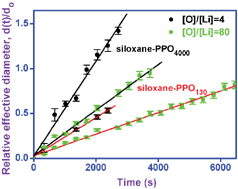The influence of lithium doping on the evolution of viscoelastic properties and structure during the gelation of siloxane–poly(oxypropylene) (PPO) nanocomposites has been studied. For several [O]/[Li] ratios (O being the oxygen of the ether-type), dynamic rheological measurements allowed us to follow the evolution of storage and loss moduli, complex viscosity and phase angle during gelation of Li+-doped hybrid sols. All samples exhibit a Newtonian viscous character in the initial step of the process and are progressively transformed into viscoelastic gels. The evolution of the rheological properties of these systems allowed us to determine the aggregation mechanisms of silicon species present in hybrid sols, which lead to sol–gel transformation: mass fractal growth and nearly linear growth at the beginning of gelation, and percolation at the final stage of the process. The influence of doping on the aggregation mechanisms depends on the polymer molecular weight: while for hybrids containing long polymer chains (Mw = 4000 g mol−1) gelation occurs in the initial stages through diffusion-limited monomer–cluster aggregation (DLMCA) for all doping levels, this mechanism is only observed for hybrids containing short chains (Mw = 130 g mol−1) at low lithium concentration ([O]/[Li] = 80). For undoped and high doped siloxane–PPO130 composites ([O]/[Li] = 4), cluster–cluster aggregation is the predominant mechanism occurring at the initial gelation stages. The nature and the proportion of the different coordination sites for lithium cations in the hybrid sols, determined by 7Li NMR and infrared spectroscopy, affect the aggregation mechanisms during gelation and the condensation degree of the siloxane phase in the final dried materials.

You have access to this article
 Please wait while we load your content...
Something went wrong. Try again?
Please wait while we load your content...
Something went wrong. Try again?


 Please wait while we load your content...
Please wait while we load your content...